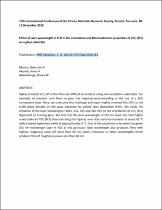 ResearchSpace
ResearchSpace
Effect of laser wavelength in PLD in the orientation and thermochromic properties of VO2 (M1) on a glass substrate
JavaScript is disabled for your browser. Some features of this site may not work without it.
- ResearchSpace
- →
- Research Publications/Outputs
- →
- Conference Publications
- →
- View Item
| dc.contributor.author |
Masina, Bathusile N

|
|
| dc.contributor.author |
Akande, Amos A

|
|
| dc.contributor.author |
Mwakikunga, Bonex W

|
|
| dc.date.accessioned | 2020-04-12T18:53:09Z | |
| dc.date.available | 2020-04-12T18:53:09Z | |
| dc.date.issued | 2019-12 | |
| dc.identifier.citation | Masina, B.N., Akande, A.A. and Mwakikunga, B.W. 2019. Effect of laser wavelength in PLD in the orientation and thermochromic properties of VO2 (M1) on a glass substrate. 10th International Conference of the African Materials Research Society, Arusha, Tanzania, 10-13 December 2019. In: MRS Advances, 1-12. doi:10.1557/adv.2020.161 | en_US |
| dc.identifier.issn | 2059-8521 | |
| dc.identifier.uri | https://www.cambridge.org/core/journals/mrs-advances/article/effect-of-laser-wavelength-in-pld-in-the-orientation-and-thermochromic-properties-of-vo2-m1-on-a-glass-substrate/1BEEB1C860A32FF5DEFFFB123F80ACC0 | |
| dc.identifier.uri | http://africanmrs.net/tanzania-2019/wp-content/uploads/2019/12/AMRS2019-draft-programme-06-12-19.pdf | |
| dc.identifier.uri | https://doi.org/10.1557/adv.2020.161 | |
| dc.identifier.uri | http://hdl.handle.net/10204/11416 | |
| dc.description | Copyright: Materials Research Society 2020. Due to copyright restrictions, the attached PDF file only contains the abstract of the full text item. For access to the full text item, please consult the publisher's website: https://doi.org/10.1557/adv.2020.161 | en_US |
| dc.description.abstract | Highly oriented VO2 (M1) thin films are difficult to produce using non-crystalline substrates. For example, to produce such films on glass has required post-annealing or the use of a ZnO transparent layer. Here, we overcome this challenge and report highly oriented VO2 (M1) in the (100) plane directly on the glass substrate by pulsed laser deposition (PLD). We study the influence of the laser wavelengths (1064, 532, 355 and 266 nm) on the orientation of VO2 (M1) deposited on Corning glass. We find that the laser wavelength of 532 nm leads the most highly a-axis textured VO2 (M1) demonstrating the highest reversible metal-to-insulator at about 62 °C with a lowest hysteresis width of approximately 9°C. One of the conditions is to select the green 532 nm wavelength laser in PLD as this particular laser wavelength also produces films with highest roughness value (of more than 60 nm) when compared to other wavelengths which produce films of roughness values less than 40 nm. | en_US |
| dc.language.iso | en | en_US |
| dc.publisher | Materials Research Society | en_US |
| dc.relation.ispartofseries | Worklist;23397 | |
| dc.subject | VO2 (M1) | en_US |
| dc.subject | Non-crystalline substrates | en_US |
| dc.title | Effect of laser wavelength in PLD in the orientation and thermochromic properties of VO2 (M1) on a glass substrate | en_US |
| dc.type | Conference Presentation | en_US |
| dc.identifier.apacitation | Masina, B. N., Akande, A. A., & Mwakikunga, B. W. (2019). Effect of laser wavelength in PLD in the orientation and thermochromic properties of VO2 (M1) on a glass substrate. Materials Research Society. http://hdl.handle.net/10204/11416 | en_ZA |
| dc.identifier.chicagocitation | Masina, Bathusile N, Amos A Akande, and Bonex W Mwakikunga. "Effect of laser wavelength in PLD in the orientation and thermochromic properties of VO2 (M1) on a glass substrate." (2019): http://hdl.handle.net/10204/11416 | en_ZA |
| dc.identifier.vancouvercitation | Masina BN, Akande AA, Mwakikunga BW, Effect of laser wavelength in PLD in the orientation and thermochromic properties of VO2 (M1) on a glass substrate; Materials Research Society; 2019. http://hdl.handle.net/10204/11416 . | en_ZA |
| dc.identifier.ris | TY - Conference Presentation AU - Masina, Bathusile N AU - Akande, Amos A AU - Mwakikunga, Bonex W AB - Highly oriented VO2 (M1) thin films are difficult to produce using non-crystalline substrates. For example, to produce such films on glass has required post-annealing or the use of a ZnO transparent layer. Here, we overcome this challenge and report highly oriented VO2 (M1) in the (100) plane directly on the glass substrate by pulsed laser deposition (PLD). We study the influence of the laser wavelengths (1064, 532, 355 and 266 nm) on the orientation of VO2 (M1) deposited on Corning glass. We find that the laser wavelength of 532 nm leads the most highly a-axis textured VO2 (M1) demonstrating the highest reversible metal-to-insulator at about 62 °C with a lowest hysteresis width of approximately 9°C. One of the conditions is to select the green 532 nm wavelength laser in PLD as this particular laser wavelength also produces films with highest roughness value (of more than 60 nm) when compared to other wavelengths which produce films of roughness values less than 40 nm. DA - 2019-12 DB - ResearchSpace DP - CSIR KW - VO2 (M1) KW - Non-crystalline substrates LK - https://researchspace.csir.co.za PY - 2019 SM - 2059-8521 T1 - Effect of laser wavelength in PLD in the orientation and thermochromic properties of VO2 (M1) on a glass substrate TI - Effect of laser wavelength in PLD in the orientation and thermochromic properties of VO2 (M1) on a glass substrate UR - http://hdl.handle.net/10204/11416 ER - | en_ZA |





